วัดพระศรีรัตนศาสดาราม หรือ วัดพระแก้ว ถนนหน้าพระลาน แขวงพระบรมมหาราชวัง เขตพระนคร กรุงเทพมหานคร.
Wat Phra Keow, Bangkok, Thailand.
Photo Gallery. Asian Historical Architecture.
ขอบคุณ ภาพและข้อมูล จาก http://www.orientalarchitecture.com/sid/612/thailand/bangkok/wat-phra-keow
Wat Phra Keow (วัดพระแก้ว) (built 1782 onward)
Wat Phra Keow, commonly called the Temple of the Emerald Buddha, was constructed in 1782 to house the Emerald Buddha, the most revered possession of the ruling Chakri dynasty. Just 60 cm tall, the Emerald Buddha is an ancient statue believed to have magical powers. It is said that whoever possesses the statue will rule the entire kingdom. No one knows the origin of the statue, but it first surfaced in the 15th century in the northern town of Chiang Rai. It was carried to Laos in the middle of the 16th century and subsequently moved to Vientiane in modern-day Laos. It was brought to Bangkok in the late 18th century by the future king Rama I, who was then serving as general under Tok Sin, the last ruler of the the previous dynasty. Made of either Jade or nephrite (close inspection is prohibited), the statue shimmers in a glass case high above the heads of tourists. Only the king is permitted to approach the statue. In a solemn ritual held three times a year, the king changes the robes of the statue to ensure blessing for his rule.
Unlike most monasteries, there are no resident monks at Wat Phra Keow. The temple is reserved for the exclusive use of the royal family.
Location
The approximate location of the site is 13.751669' N, 100.492767' E (WGS 84 map datum).
วัดพระศรีรัตนศาสดาราม หรือ วัดพระแก้ว ถนนหน้าพระลาน แขวงพระบรมมหาราชวัง เขตพระนคร กรุงเทพมหานคร.
02.Wat Phra Keow, Bangkok, Thailand. Photo Gallery. Asian Historical Architecture.
วัดพระศรีรัตนศาสดาราม หรือ วัดพระแก้ว ถนนหน้าพระลาน แขวงพระบรมมหาราชวัง เขตพระนคร กรุงเทพมหานคร.
03.Wat Phra Keow, Bangkok, Thailand. Photo Gallery. Asian Historical Architecture.
วัดพระศรีรัตนศาสดาราม หรือ วัดพระแก้ว ถนนหน้าพระลาน แขวงพระบรมมหาราชวัง เขตพระนคร กรุงเทพมหานคร.
04.Wat Phra Keow, Bangkok, Thailand. Photo Gallery. Asian Historical Architecture.
วัดพระศรีรัตนศาสดาราม หรือ วัดพระแก้ว ถนนหน้าพระลาน แขวงพระบรมมหาราชวัง เขตพระนคร กรุงเทพมหานคร.
05.Wat Phra Keow, Bangkok, Thailand. Photo Gallery. Asian Historical Architecture.
วัดพระศรีรัตนศาสดาราม หรือ วัดพระแก้ว ถนนหน้าพระลาน แขวงพระบรมมหาราชวัง เขตพระนคร กรุงเทพมหานคร.
06.Wat Phra Keow, Bangkok, Thailand. Photo Gallery. Asian Historical Architecture.
วัดพระศรีรัตนศาสดาราม หรือ วัดพระแก้ว ถนนหน้าพระลาน แขวงพระบรมมหาราชวัง เขตพระนคร กรุงเทพมหานคร.
07.Wat Phra Keow, Bangkok, Thailand. Photo Gallery. Asian Historical Architecture.
วัดพระศรีรัตนศาสดาราม หรือ วัดพระแก้ว ถนนหน้าพระลาน แขวงพระบรมมหาราชวัง เขตพระนคร กรุงเทพมหานคร.
08.Wat Phra Keow, Bangkok, Thailand. Photo Gallery. Asian Historical Architecture.
วัดพระศรีรัตนศาสดาราม หรือ วัดพระแก้ว ถนนหน้าพระลาน แขวงพระบรมมหาราชวัง เขตพระนคร กรุงเทพมหานคร.
09.Wat Phra Keow, Bangkok, Thailand. Photo Gallery. Asian Historical Architecture.
วัดพระศรีรัตนศาสดาราม หรือ วัดพระแก้ว ถนนหน้าพระลาน แขวงพระบรมมหาราชวัง เขตพระนคร กรุงเทพมหานคร.
10.Wat Phra Keow, Bangkok, Thailand. Photo Gallery. Asian Historical Architecture.
วัดพระศรีรัตนศาสดาราม หรือ วัดพระแก้ว ถนนหน้าพระลาน แขวงพระบรมมหาราชวัง เขตพระนคร กรุงเทพมหานคร.
11.Wat Phra Keow, Bangkok, Thailand. Photo Gallery. Asian Historical Architecture.
วัดพระศรีรัตนศาสดาราม หรือ วัดพระแก้ว ถนนหน้าพระลาน แขวงพระบรมมหาราชวัง เขตพระนคร กรุงเทพมหานคร.
12.Wat Phra Keow, Bangkok, Thailand. Photo Gallery. Asian Historical Architecture.
วัดพระศรีรัตนศาสดาราม หรือ วัดพระแก้ว ถนนหน้าพระลาน แขวงพระบรมมหาราชวัง เขตพระนคร กรุงเทพมหานคร.
13.Wat Phra Keow, Bangkok, Thailand. Photo Gallery. Asian Historical Architecture.
วัดพระศรีรัตนศาสดาราม หรือ วัดพระแก้ว ถนนหน้าพระลาน แขวงพระบรมมหาราชวัง เขตพระนคร กรุงเทพมหานคร.
14.Wat Phra Keow, Bangkok, Thailand. Photo Gallery. Asian Historical Architecture.
วัดพระศรีรัตนศาสดาราม หรือ วัดพระแก้ว ถนนหน้าพระลาน แขวงพระบรมมหาราชวัง เขตพระนคร กรุงเทพมหานคร.
15.Wat Phra Keow, Bangkok, Thailand. Photo Gallery. Asian Historical Architecture.
วัดพระศรีรัตนศาสดาราม หรือ วัดพระแก้ว ถนนหน้าพระลาน แขวงพระบรมมหาราชวัง เขตพระนคร กรุงเทพมหานคร.
16.Wat Phra Keow, Bangkok, Thailand. Photo Gallery. Asian Historical Architecture.
วัดพระศรีรัตนศาสดาราม หรือ วัดพระแก้ว ถนนหน้าพระลาน แขวงพระบรมมหาราชวัง เขตพระนคร กรุงเทพมหานคร.
17.Wat Phra Keow, Bangkok, Thailand. Photo Gallery. Asian Historical Architecture.
วัดพระศรีรัตนศาสดาราม หรือ วัดพระแก้ว ถนนหน้าพระลาน แขวงพระบรมมหาราชวัง เขตพระนคร กรุงเทพมหานคร.
18.Wat Phra Keow, Bangkok, Thailand. Photo Gallery. Asian Historical Architecture.
วัดพระศรีรัตนศาสดาราม หรือ วัดพระแก้ว ถนนหน้าพระลาน แขวงพระบรมมหาราชวัง เขตพระนคร กรุงเทพมหานคร.
19.Wat Phra Keow, Bangkok, Thailand. Photo Gallery. Asian Historical Architecture.
วัดพระศรีรัตนศาสดาราม หรือ วัดพระแก้ว ถนนหน้าพระลาน แขวงพระบรมมหาราชวัง เขตพระนคร กรุงเทพมหานคร.
20.Wat Phra Keow, Bangkok, Thailand. Photo Gallery. Asian Historical Architecture.
วัดพระศรีรัตนศาสดาราม หรือ วัดพระแก้ว ถนนหน้าพระลาน แขวงพระบรมมหาราชวัง เขตพระนคร กรุงเทพมหานคร.
21.Wat Phra Keow, Bangkok, Thailand. Photo Gallery. Asian Historical Architecture.
วัดพระศรีรัตนศาสดาราม หรือ วัดพระแก้ว ถนนหน้าพระลาน แขวงพระบรมมหาราชวัง เขตพระนคร กรุงเทพมหานคร.
22.Wat Phra Keow, Bangkok, Thailand. Photo Gallery. Asian Historical Architecture.
วัดพระศรีรัตนศาสดาราม หรือ วัดพระแก้ว ถนนหน้าพระลาน แขวงพระบรมมหาราชวัง เขตพระนคร กรุงเทพมหานคร.
23.Wat Phra Keow, Bangkok, Thailand. Photo Gallery. Asian Historical Architecture.
วัดพระศรีรัตนศาสดาราม หรือ วัดพระแก้ว ถนนหน้าพระลาน แขวงพระบรมมหาราชวัง เขตพระนคร กรุงเทพมหานคร.
24.Wat Phra Keow, Bangkok, Thailand. Photo Gallery. Asian Historical Architecture.
วัดพระศรีรัตนศาสดาราม หรือ วัดพระแก้ว ถนนหน้าพระลาน แขวงพระบรมมหาราชวัง เขตพระนคร กรุงเทพมหานคร.
25.Wat Phra Keow, Bangkok, Thailand. Photo Gallery. Asian Historical Architecture.
วัดพระศรีรัตนศาสดาราม หรือ วัดพระแก้ว ถนนหน้าพระลาน แขวงพระบรมมหาราชวัง เขตพระนคร กรุงเทพมหานคร.
26.Wat Phra Keow, Bangkok, Thailand. Photo Gallery. Asian Historical Architecture.
วัดพระศรีรัตนศาสดาราม หรือ วัดพระแก้ว ถนนหน้าพระลาน แขวงพระบรมมหาราชวัง เขตพระนคร กรุงเทพมหานคร.
27.Wat Phra Keow, Bangkok, Thailand. Photo Gallery. Asian Historical Architecture.
วัดพระศรีรัตนศาสดาราม หรือ วัดพระแก้ว ถนนหน้าพระลาน แขวงพระบรมมหาราชวัง เขตพระนคร กรุงเทพมหานคร.
28.Wat Phra Keow, Bangkok, Thailand. Photo Gallery. Asian Historical Architecture.
วัดพระศรีรัตนศาสดาราม หรือ วัดพระแก้ว ถนนหน้าพระลาน แขวงพระบรมมหาราชวัง เขตพระนคร กรุงเทพมหานคร.
29.Wat Phra Keow, Bangkok, Thailand. Photo Gallery. Asian Historical Architecture.
วัดพระศรีรัตนศาสดาราม หรือ วัดพระแก้ว ถนนหน้าพระลาน แขวงพระบรมมหาราชวัง เขตพระนคร กรุงเทพมหานคร.
30.Wat Phra Keow, Bangkok, Thailand. Photo Gallery. Asian Historical Architecture.
วัดพระศรีรัตนศาสดาราม หรือ วัดพระแก้ว ถนนหน้าพระลาน แขวงพระบรมมหาราชวัง เขตพระนคร กรุงเทพมหานคร.
31.Wat Phra Keow, Bangkok, Thailand. Photo Gallery. Asian Historical Architecture.
วัดพระศรีรัตนศาสดาราม หรือ วัดพระแก้ว ถนนหน้าพระลาน แขวงพระบรมมหาราชวัง เขตพระนคร กรุงเทพมหานคร.
32.Wat Phra Keow, Bangkok, Thailand. Photo Gallery. Asian Historical Architecture.
วัดพระศรีรัตนศาสดาราม หรือ วัดพระแก้ว ถนนหน้าพระลาน แขวงพระบรมมหาราชวัง เขตพระนคร กรุงเทพมหานคร.
33.Wat Phra Keow, Bangkok, Thailand. Photo Gallery. Asian Historical Architecture.
วัดพระศรีรัตนศาสดาราม หรือ วัดพระแก้ว ถนนหน้าพระลาน แขวงพระบรมมหาราชวัง เขตพระนคร กรุงเทพมหานคร.
34.Wat Phra Keow, Bangkok, Thailand. Photo Gallery. Asian Historical Architecture.
วัดพระศรีรัตนศาสดาราม หรือ วัดพระแก้ว ถนนหน้าพระลาน แขวงพระบรมมหาราชวัง เขตพระนคร กรุงเทพมหานคร.
35.Wat Phra Keow, Bangkok, Thailand. Photo Gallery. Asian Historical Architecture.
วัดพระศรีรัตนศาสดาราม หรือ วัดพระแก้ว ถนนหน้าพระลาน แขวงพระบรมมหาราชวัง เขตพระนคร กรุงเทพมหานคร.
36.Wat Phra Keow, Bangkok, Thailand. Photo Gallery. Asian Historical Architecture.
วัดพระศรีรัตนศาสดาราม หรือ วัดพระแก้ว ถนนหน้าพระลาน แขวงพระบรมมหาราชวัง เขตพระนคร กรุงเทพมหานคร.
37.Wat Phra Keow, Bangkok, Thailand. Photo Gallery. Asian Historical Architecture.
วัดพระศรีรัตนศาสดาราม หรือ วัดพระแก้ว ถนนหน้าพระลาน แขวงพระบรมมหาราชวัง เขตพระนคร กรุงเทพมหานคร.
38.Wat Phra Keow, Bangkok, Thailand. Photo Gallery. Asian Historical Architecture.
วัดพระศรีรัตนศาสดาราม หรือ วัดพระแก้ว ถนนหน้าพระลาน แขวงพระบรมมหาราชวัง เขตพระนคร กรุงเทพมหานคร.
39.Wat Phra Keow, Bangkok, Thailand. Photo Gallery. Asian Historical Architecture.
วัดพระศรีรัตนศาสดาราม หรือ วัดพระแก้ว ถนนหน้าพระลาน แขวงพระบรมมหาราชวัง เขตพระนคร กรุงเทพมหานคร.
40.Wat Phra Keow, Bangkok, Thailand. Photo Gallery. Asian Historical Architecture.
วัดพระศรีรัตนศาสดาราม หรือ วัดพระแก้ว ถนนหน้าพระลาน แขวงพระบรมมหาราชวัง เขตพระนคร กรุงเทพมหานคร.
41.Wat Phra Keow, Bangkok, Thailand. Photo Gallery. Asian Historical Architecture.
วัดพระศรีรัตนศาสดาราม หรือ วัดพระแก้ว ถนนหน้าพระลาน แขวงพระบรมมหาราชวัง เขตพระนคร กรุงเทพมหานคร.
42.Wat Phra Keow, Bangkok, Thailand. Photo Gallery. Asian Historical Architecture.
วัดพระศรีรัตนศาสดาราม หรือ วัดพระแก้ว ถนนหน้าพระลาน แขวงพระบรมมหาราชวัง เขตพระนคร กรุงเทพมหานคร.
43.Wat Phra Keow, Bangkok, Thailand. Photo Gallery. Asian Historical Architecture.
วัดพระศรีรัตนศาสดาราม หรือ วัดพระแก้ว ถนนหน้าพระลาน แขวงพระบรมมหาราชวัง เขตพระนคร กรุงเทพมหานคร.
44.Wat Phra Keow, Bangkok, Thailand. Photo Gallery. Asian Historical Architecture.
วัดพระศรีรัตนศาสดาราม หรือ วัดพระแก้ว ถนนหน้าพระลาน แขวงพระบรมมหาราชวัง เขตพระนคร กรุงเทพมหานคร.
45.Wat Phra Keow, Bangkok, Thailand. Photo Gallery. Asian Historical Architecture.
วัดพระศรีรัตนศาสดาราม หรือ วัดพระแก้ว ถนนหน้าพระลาน แขวงพระบรมมหาราชวัง เขตพระนคร กรุงเทพมหานคร.
Wat Phra Keow, Bangkok, Thailand.
1.Thotsakhirithon (ทศคีรีธร), giant demon (Yaksha) guarding an exit to Grand Palace
2.A Wat Phra Kaew Inner Compound Structure
3.Wat Phra Kaew from entrance
4.View of the Temple of Emerald Buddha and Golden Stupa
5.Wat Phra Kaew at night
6.A row of prangs in Wat Phra Kaew
7.Detail of a kinnara-statue
8.Garuda and Nagas, at the outside of the ubosot
9.Entrance to Phra Mondop
10.Nāga at the entrance to Phra Mondop
11.Royal Pantheon of Wat Phra Kaew
12.Kinare – mythological creature, half bird, half man
13.Phra Mondop (the library) and Phra Sri Rattana Chedi
วัดพระศรีรัตนศาสดาราม หรือ วัดพระแก้ว ถนนหน้าพระลาน แขวงพระบรมมหาราชวัง เขตพระนคร กรุงเทพมหานคร.
Wat Phra Keow, Bangkok, Thailand.
Photo Gallery. Asian Historical Architecture.
ขอบคุณ ภาพและข้อมูล จาก http://www.orientalarchitecture.com/sid/612/thailand/bangkok/wat-phra-keow
---------------------------------------------------------------------------------
ขอบคุณ ข้อมูลและภาพ จากhttps://en.wikipedia.org/wiki/Wat_Phra_Kaew
Wat Phra Kaew
From Wikipedia, the free encyclopedia
| Wat Phra Kaew Temple of the Emerald Buddha | |
|---|---|
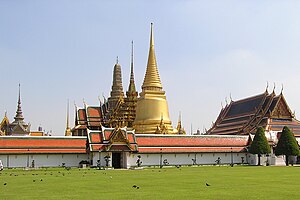
View of Wat Phra Kaew Complex from northeast.
| |
| Basic information | |
| Geographic coordinates | 13°45′5″N 100°29′33″ECoordinates: 13°45′5″N 100°29′33″E |
| Affiliation | Theravada Buddhism |
| Country | Phra Nakhon District, Bangkok, Thailand |
| Website | watphrakaew |
| Architectural description | |
| Founder | King Phutthayotfa Chulalok(Rama I) |
| Completed | 18th Century |
Wat Phra Kaew[1] is regarded as the most sacred Buddhist temple (wat) in Thailand. The Emerald Buddha housed in the temple is a potent religio-political symbol and the palladium (protective image) of Thai society.[2][3] It is located in Phra Nakhon District, the historic centre of Bangkok, within the precincts of the Grand Palace.[4][5]
The main building is the central phra ubosot, which houses the statue of the Emerald Buddha. According to legend, this Buddha image originated in India where the sage Nagasena prophesized that the Emerald Buddha would bring "prosperity and pre-eminence to each country in which it resides", the Emerald Buddha deified in the Wat Phra Kaew is therefore deeply revered and venerated in Thailand as the protector of the country. Historical records however dates its finding to Chiang Rai in the 15th century where, after it was relocated a number of times, it was finally taken to Thailand in the 18th century. It was enshrined in Bangkok at the Wat Phra Kaew temple in 1782 during the reign of Phutthayotfa Chulalok, King Rama I (1782–1809). This marked the beginning of the Chakri Dynasty of Thailand, whose current sovereign is Vajiralongkorn, King Rama X.
The Emerald Buddha, a dark green statue, is in a standing form, about 66 centimetres (26 in) tall, carved from a single jade stone ("emerald" in Thai means deep green colour and not the specific stone). It is carved in the meditating posture in the style of the Lanna school of the northern Thailand. Except for the Thai King and, in his stead, the Crown Prince, no other persons are allowed to touch the statue. The King changes the cloak around the statue three times a year, corresponding to the summer, winter, and rainy seasons, an important ritual performed to usher good fortune to the country during each season.[3][4][5]
Contents
[hide]History[edit]
In 1767, the Kingdom of Ayutthaya fell to the Burmese, and King Taksinthen moved the capital to Thonburi where he built the old palace beside Wat Arun on the west bank of Chao Phraya River. In 1778, Taksin's army under the command of Chao Phraya Chakri (who later became Rama I) captured Vientiane and took the Emerald Buddha back to Thonburi.
In 1782, King Rama I succeeded to the throne and founded the Chakri Dynasty, and he decided to move the capital across the river to Bangkok as it would be better protected from attack.[6] The site chosen for the palace is situated between two old wats, Wat Pho and Wat Mahathat, an area inhabited by Chinese residents who were then moved to the present Chinatown.[7] He started the construction of the Grand Palace so that the palace may be ready for his coronation in 1785. Wat Phra Kaew, which has its own compound within the precinct of the palace, was built to house the Emerald Buddha, which is considered a sacred object that provides protection for the kingdom. Wat Phra Kaew was completed in 1784.[2][8] The formal name of Wat Phra Kaeo is Phra Sri Rattana Satsadaram, which means "the residence of the Holy Jewel Buddha."
Wat Phra Kaew has undergone a number of renovations, restoration and additions in its history, particularly during the reign of King Rama III and Rama IV. Rama III started the renovations and rebuilding in 1831 for the 50th Anniversary of BangkoK of 1832, while Rama IV's restoration was completed by Rama V in time for the Bangkok Centennial celebrations in 1882. Further restoration was undertaken by Rama VIIon Bangkok's 150th Anniversary in 1932, and by Rama IX for the 200th Anniversary in 1982.[2]
Emerald Buddha[edit]
It is not known when the statue of the Emerald Buddha was made, but it is generally believed that it was crafted in 14th-century Thailand.[5] However, there are also claims that the statue originated in India or Sri Lanka.[9] None of these theories can be firmly established as none of the historians could get a close look at the statue.[3][5]
According to one account, the Emerald Buddha was found in Chiang Rai, Lanna in 1434, after a lightning storm struck a temple. The Buddha statue fell down and later became chipped, and the monks, after removing the stucco around the statue, discovered that the image was a perfectly made Buddha image from a solid piece of green jade. The image was moved a few time to various temples, first to Lampang, then to Chiang Mai, from where it was removed by prince Chao Chaiyasetthathirat to Luang Prabang, when his father died and he ascended the throne of both Lanna and Lan Xang, in 1551. The statue remained the it to his new capital of Lan Xang in Vientiane in the 1560s. The statue remained there for twelve years. King Chaiyasetthathirat then shifted it to his new capital of Lan Xang in Vientiane in the 1560s. He took the Emerald Buddha with him and the image remained in Vientiane for 214 years until 1778.[9]
In the reign of King Taksin, Chao Phya Chakri (who later became Rama I) defeated Vientiane and moved the Emerald Buddha from Vientiane to Thonburi where it was installed in a shrine close to Wat Arun. When Chao Phra Chakri took over the throne and founded the Chakri Dynasty of the Rattanakosin Kingdom, he shifted his capital across the river to its present location in Bangkok. The Emerald Buddha was also moved across the river with pomp and pageantry and installed in the temple of Wat Phra Keaw.[3][5]
Legends[edit]
There a number of legends associated with the Emerald Buddha. It was said the iconic image of the Emerald Buddha was made by Nagasena, a saint in Pataliputra (present day Patna), India, who, with the help of Hindu god Vishnu and demigod Indra, had the Emerald Buddha image made. Nagasena predicted that:[3]
The Emerald Buddha image was taken to Sri Lanka after three hundred years in Pataliputra to save it during a civil war. In 457, King Anuruth of Burma sent a mission to Ceylon with a request for Buddhist scriptures and the Emerald Buddha, in order to promote Buddhism in his country. These requests were granted, but the ship lost its way in a storm during the return voyage and landed in Cambodia. When the Thais captured Angkor Wat in 1432 (following the ravage of the bubonic plague), the Emerald Buddha was taken to Ayutthaya, Kamphaeng Phet, Laos and finally Chiang Rai, where the ruler of the city hid it, and was later found.[3]
Architecture[edit]
Wat Phra Kaew has a plethora of buildings within the precincts of the Grand Palace, which covers a total area of over 94.5 hectares (234 acres). It has over 100 buildings with “200 years royal history and architectural experimentation” linked to it. The architectural style is named as Rattanakosin style (old Bangkok style). The main temple of the Emerald Buddha is very elegantly decorated and similar to the temple in ancient capital of Ayudhya. The roof is embellished with polished orange and green tiles, the pillars are inlaid in mosaic and the pediments are made of rich marble, installed around 18th century. The Emerald Buddha is deified over an elevated altar surrounded by large gilded decorations. While the upper part of this altar was part of the original construction, the base was added by King Rama III. Two images of the Buddha, which represent the first two kings of the Chakri dynasty, flank the main image. Over the years, the temple has retained its original design. However, minor improvements have been effected after its first erection during Rama I's reign; wood-work of the temple was replaced by King Rama III and King Chulalongkorn; during King Mongkut's reign, the elegant doors and windows and the copper plates on the floor were additions, Rama III refurbished the wall painting (indicative of the universe according to Buddhist cosmology) and several frescoes that display the various stages of the Buddha's life; three chambers were added on the western side by King Mongkut; in the chamber known as 'Phra Kromanusorn' at the northern end, images of Buddha have been installed in honour of the kings of Ayutthaya; and in the 19th century, Khrua In Khong, a famous painter executed the wall murals. The entry to the temple is from the third gate from the river pier.[3][5][10][11][12][13][14]
The entrance is guarded by a pair of yakshis (mythical giants – 5 metres (16 ft) high statues). The eponymous image Buddha in brilliant green colour is 66 centimetres (26 in) in height with a lap width of 48.3 centimetres (19.0 in). It is carved in a yogic position, known as Virasana (a meditation pose commonly seen in images in Thailand and also in South India, Sri Lanka and Southeast Asia). The pedestal on which the Emerald Buddha deified is decorated with Garuda (the mythical half-man half-bird form, a steed of Rama, who holds his mortal enemy Naga the serpent in his legs) motifs It is central to Thai Buddhism. The image made with a circular base has a smooth top-knot that is finished with a "dulled point marking at the top of the image". A third eye made in gold is inset over the elevated eyebrows of the image. The image appears divine and composed, with the eyes cast downward. The image has a small nose and mouth (mouth closed) and elongated ears. The hands are seen on the lap with palms facing upwards.[3][12][15]
The entire complex, including the temples, is bounded by a compound wall which is one of the most prominent part of the wat is about 2 kilometres (6,600 ft) length. The compound walls are decorated with typically Thai murals, based on the Indian epic Ramayana. In Thai language these murals are known to form the Ramakian, the Thai national epic, which was written during the reign of Rama I. The epic stories formed the basic information to draw the paintings during the reign of King Rama I (1782–1809). These paintings are refurbished regularly. The murals, in 178 scenes, starting with the north gate of the temple illustrates the complete epic story of Ramayana sequentially, in a clockwise direction covering the entire compound wall. The murals serve to emphasise human values of honesty, faith, and devotion.[3][5][10][13]
There are twelve salas that were built by Rama I, around the temple. They house interesting artefacts of regions such as Cambodia and Java. One of these salas had an inscription of Ramkamhaeng, which was shifted, in 1924, to the National Library. During the reign of King Mongkut, the Phra Gandharara – small chapel on the southwest corner – and a tall belfry were new additions.[3]
Worship and ceremonies[edit]
Early in the Bangkok period, the Emerald Buddha used to be taken out of its temple and paraded in the streets to relieve the city and countryside of various calamities (such as plague and cholera). However, this practice was discontinued during Rama IV's reign as it was feared that the image could get damaged during the procession and also a practical line of thinking that Rama IV held "that diseases are caused by germs, not by evil spirits or the displeasure of the Buddha". The image also marks the changing of the seasons in Thailand, with the king presiding over the seasonal ceremonies.[3]
Like many other Buddha statues in Thailand, the Emerald Buddha is dressed in a seasonal costume. It is a significant ritual held at this temple. In this ritual, dress of the deity is changed three times a year to correspond to the seasons. In summer it is a pointed crown of gold and jewels, and a set of jewelled ornaments that adorns the image from the shoulders to the ankles. In winter, a meshed dressing gown or drapery made of gold beads, which covered from the neck down like a poncho is used. During the rainy months, a top-knot headdress studded with gold, enamel and sapphires; the gold attire in the rainy season is draped over the left shoulder of the deity, only with the right shoulder left bare while gold ornaments embellish the image up to the ankles. The astrological dates for the ritual ceremonies, at the changing of the seasons, followed are in the 1st Waning Moon of Lunar Months 4, 8 and 12 (around March, July and November). The costume change ritual is performed by the Thai king who is the highest master of ceremonies for all Buddhist rites. On each occasion, the king himself "cleans the image by wiping away any dust that has collected and changing the headdress of the image". Then a king's royal attendant climbs up and performs the elaborate ritual of changing garments of the image as the king is chanting prayers to the deity. On this occasion, the king sprinkles water over the monks and the faithful who have assembled to witness the unique ritual and seeks blessings of the deity for good fortune during the upcoming season. The two sets of clothing not in use at any given time are kept on display in the nearby Pavilion of Regalia, Royal Decorations and Coins in the precincts of the Grand Palace. While Rama I initiated this ritual for the hot season and the rainy season, Rama III introduced the ritual for the winter season.[3][5] The robes, which the image adorns, represents that of monks and King's depending on the season, a clear indication of highlighting its symbolic role "as Buddha and the King", which role is also enjoined on the Thai King who formally dresses the Emerald Buddha image.[15]
A ceremony that is observed in the wat is the Chakri Day (begun on April 6, 1782), a national holiday to honour founding of the Chakri dynasty. On this day, the king attends the ceremony. The former king Rama IX, with his Queen, and entourage of the royal family, the Prime Minister, officials in the Ministry of Defence, and other government departments, first offered prayers at the Emerald Buddha temple. This was followed by visit to the pantheon to pay homage to the images of past Chakri rulers that are installed there.[3]
The coronation ceremony, which marks the crowning of the king, is an important event of the Chakri dynasty. One such recent event took place when Rama IX was crowned the King. On this occasion, the King came to the Chapel Royal- the Wat Phra Keo – in a procession wearing a 'Great Crown'. After entering the chapel, the king made offerings of gold and silver flowers to the deity and also lighted candles. He also paid homage to the images of Buddha that represented the past kings of the dynasty. In the presence of assembled elite clergy of the kingdom, he took a formal vow of his religion and his steadfastness to 'Defend the Faith'.[3]
Rules of entry and conduct[edit]
The sacred temples in Thailand follow a dress code, which is strictly followed. Men must wear long trousers and sleeved shirts and shoes; women must wear long skirts. Visitors who arrive dressed otherwise may rent appropriate clothing items at the entry area of the temple. It is compulsory to remove the shoes before entering the temple, as a sign of respect of the Buddha, as is the practice in all other temples in Thailand. While offering prayers before the Buddha image, the sitting posture should avoid any offensive stretching of feet towards the deity; the feet should be tucked in towards the back.[10]
Other monuments[edit]
While the surrounding portico of the shrine is an example of Thai craftsmanship, the perimeter of the temple complex has 12 open pavilions. These were built during the reign of Rama I.[5] There is plethora of monuments in the temple complex. These are:
- Grand Palace
The former residence of the King, the Grand Palace, adjoins the temple. The King makes use of this Grand Palace for ceremonial functions such as the Coronation Day. The King’s present residence is to the north of this Grand Palace and is known as the Chitlada Palace. The four structures surrounding the temple have history of their own. At the eastern end is the Borombhiman Hall (built in French architectural design), which was the residence of King Rama VI, now used as guest house for visiting foreign dignitaries. It has the dubious distinction of having been used as the operational headquarters and residence of General Chitpatima who attempted a coup, in 1981. The building to the west is the Amarindra hall, earlier a hall of Justice, now used for formal ceremonies. The Chakri Mahaprasat is the largest hall in the Grand Palace, built in 1882 by British architects, the architecture of which is fusion of Italian renaissance and Traditional Thai architecture. This style is called farang sai chada, (meaning: "Westerner wearing a Thai crown") as each wing has a shrine (mandap) crowned by a spire. Ashes of the Chakri kings (five ancestors) are enshrined in the largest of these shrines, also known as the pantheons, that were rebuilt after a fire in 1903 during Rama IV's reign. Ashes of the Chakri princess who could not become kings are enshrined in an adjoining hall. The throne room and the reception hall are on the first floor, while the ground floor houses a collection of weapons. The inner palace had the King’s harem (the practice was discontinued during King Rama VI's time who decreed the one wife rule), which was guarded by well trained female guards. Another hall in the palace is the 'Dusit hall' in Ratanokosin-style, which runs from east to west, which was initially an audience hall but now converted into a funerary hall for the Royal family. Royal family corpses are kept here for one year before they are cremated in a nearby field. There is also a garden which was laid during rama IV's reign. The garden depicts a "Thai mountain-and-woods-fable" mountain scenes where the coming of age ritual of shaving the topknot of the Prince is performed.[3][10][16]
- Pagodas
The temple grounds also depict three pagodas to its immediate north, which represent the changing centres of Buddhist influence. One such shrine to the west of the temple is the Phra Si Ratana Chedi, a 19th-century stupa built in Sri Lankan style enshrining ashes of the Buddha.[5]
- The Library
Rama I also built a library in Thai style, in the middle of the complex, known as the "Phra Mondop". The library houses an elegantly carved Ayutthaya-style mother-of-pearl doors, bookcases with the Tripitaka (sacred Buddhist manuscripts), human-and dragon-headed nagas (snakes), and images of Chakri kings.[5]
During the 19th century, the Royal Pantheon was built in Khmer style to the east of the temple, which is kept open for only one day in year, in the month of October to commemorate the founding of the Chakri dynasty.[5]
- Model of Angkor Wat
The temple complex also contains a model of Angkor Wat (the most sacred of all Cambodian shrines). In 1860, King Mongkut ordered his generals to lead 2,000 men to dismantle Angkor Wat and take it to Bangkok. Modern scholars suggested that the king wanted to show that Siam was still in control of Cambodia, as France was seeking to colonise Cambodia at that time. However, the king's order could not be fulfilled. A royal chronicle written by Lord Thiphakorawong (Kham Bunnag), then foreign minister, recorded that many Thai men fell ill after entering Cambodian wilderness. The chronicle also stated that forest-dwelling Khmer people ambushed the Thai army, killing many leading generals. King Mongkut then ordered the construction of the model within Wat Phra Kaew, instead of the real Angkor Wat that could not be brought to Bangkok. Mongkut died before he could see the model. Its construction was completed in the reign of his son, Chulalongkorn.[17]
- Hermit statue
A hermit's bronze image, which is believed to have healing powers, is installed in a sala on the western side of the temple. It is near the entry gate. It is a black stone statue, considered a patron of medicine, before which relatives of the sick and infirm pay respects and make offerings of joss sticks, fruit, flowers, and candles.[3][5]
- Eight towers
On the eastern side of the temple premises there are eight towers or prangs, each of a different colour. They were erected during the reign of Rama I and represent eight elements of Buddhism.[18]
- Elephant statues
Statues of elephants, which symbolize independence and power, are seen all around the complex. As Thai kings fought wars mounted on elephants, it has become customary for parents to make their children circumambulate the elephant three times with the belief that it would bring them strength. The head of an elephant statue is also rubbed for good luck; this act of the people is reflected in the smoothness of the surface of elephant statues here.[5]
Map[edit]
| Map of Wat Phra Kaew | ||
|---|---|---|
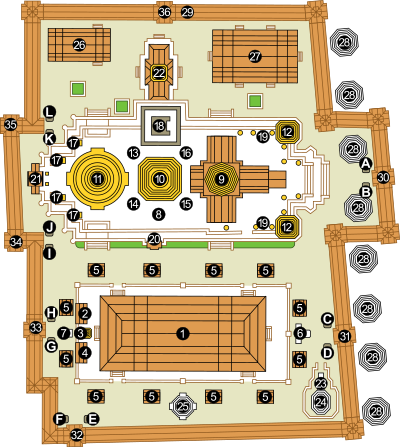 |
|
|
| ||
Gallery
2.A Wat Phra Kaew Inner Compound Structure
3.Wat Phra Kaew from entrance
4.View of the Temple of Emerald Buddha and Golden Stupa
5.Wat Phra Kaew at night
6.A row of prangs in Wat Phra Kaew
7.Detail of a kinnara-statue
8.Garuda and Nagas, at the outside of the ubosot
9.Entrance to Phra Mondop
10.Nāga at the entrance to Phra Mondop
11.Royal Pantheon of Wat Phra Kaew
12.Kinare – mythological creature, half bird, half man
13.Phra Mondop (the library) and Phra Sri Rattana Chedi
--------------------------------------------------------------------------------
ขอบคุณ ข้อมูลและภาพ จาก https://th.wikipedia.org/wiki/วัดพระศรีรัตนศาสดาราม หรือ วัดพระแก้ว
------------------------------------------------------------------------------
ขอบคุณ ข้อมูลและภาพ จาก https://th.wikipedia.org/wiki/วัดพระศรีรัตนศาสดาราม หรือ วัดพระแก้ว
วัดพระศรีรัตนศาสดาราม
จากวิกิพีเดีย สารานุกรมเสรี
| วัดพระศรีรัตนศาสดาราม | |
|---|---|

กลุ่มพระอุโบสถ เมื่อมองจากบริเวณทางเข้า
| |
| ข้อมูลทั่วไป | |
| ชื่อ | วัดพระแก้ว Wat Phra Kaew |
| ที่ตั้ง | ถนนหน้าพระลาน แขวงพระบรมมหาราชวัง เขตพระนคร 10200 |
| ประเภท | พระอารามหลวงชั้นพิเศษ |
| พระประธาน | พระพุทธมหามณีรัตนปฏิมากร |
| พระพุทธรูปสำคัญ | พระพุทธยอดฟ้าจุฬาโลก พระพุทธเลิศหล้านภาลัย พระสัมพุทธพรรณี พระชัยหลังช้าง พระคันธารราษฎร์ พระนาก |
| พระจำพรรษา | ไม่มีพระสงฆ์จำพรรษา |
| พระอารามประจำ พระบรมมหาราชวัง | |
| จุดสนใจ | สักการะพระแก้วมรกต ชมจิตรกรรมฝาผนัง ที่พระระเบียง |
| กิจกรรม | เทศนาธรรม วันอาทิตย์ และวันพระ |
| การถ่ายภาพ | ไม่ควรใช้แฟลช ในถ่ายภาพจิตรกรรมฝาผนัง และไม่อนุญาตให้ถ่ายภาพ ภายในพระอุโบสถเด็ดขาด ฝ่าฝืนมีโทษปรับ และยึดฟิล์ม/สื่อบันทึก |
| หมายเหตุ | |
วัดพระศรีรัตนศาสดารามหรือที่เรียกกันทั่วไปว่าวัดพระแก้วเป็นวัดที่พระบาทสมเด็จพระพุทธยอดฟ้าจุฬาโลกมหาราชโปรดเกล้าฯให้สร้างขึ้นในพ.ศ. 2325 เป็นวัดในพระบรมมหาราชวังเช่นเดียวกับวัดพระศรีสรรเพชญ์ ซึ่งเป็นวัดในพระราชวังหลวงในสมัยอยุธยา และมีพระราชประสงค์ให้วัดพระศรีรัตนศาสดารามเป็นที่ประดิษฐาน พระพุทธมหามณีรัตนปฏิมากร หรือพระแก้วมรกต พระคู่บ้านคู่เมืองของแผ่นดินสยามที่พบ ณ วัดป่าเยี้ยะ(ป่าไผ่) จ.เชียงราย และเป็นสถานที่ทรงบำเพ็ญพระราชกุศล วัดพระศรีรัตนศาสดารามเป็นวัดที่ไม่มีพระสงฆ์จำพรรษาอยู่ เพราะมีแต่ส่วนพุทธาวาสไม่มีส่วนสังฆาวาส
เนื้อหา
[ซ่อน]อาคารต่างๆในวัดพระศรีรัตนศาสดาราม[แก้]
เนื่องจากภายในวัดพระศรีรัตนศาสดารามมีอาคารสำคัญและอาคารประกอบเป็นจำนวนมาก จึงแบ่งกลุ่มอาคารออกเป็น 3 กลุ่ม ตามตำแหน่งและความสำคัญ ดังนี้
กลุ่มพระอุโบสถ[แก้]
กลุ่มพระอุโบสถ เป็นกลุ่มที่มีความสำคัญสูงสุด มีพระอุโบสถเป็นอาคารประธานซึ่งเป็นที่ประดิษฐานพระพุทธมหามณีรัตนปฏิมากร ล้อมรอบด้วยศาลาราย พระโพธิ์ธาตุพิมาน หอราชพงศานุสรณ์ หอราชกรมานุสรณ์ หอระฆัง และ หอพระคันธารราษฎร์
พระอุโบสถ[แก้]
พระอุโบสถ ตั้งอยู่ส่วนกลางของวัดพระศรีรัตนศาสดาราม มีกำแพงแก้วล้อมรอบ มีซุ้มประดิษฐานเสมารวม 8 ซุ้ม พระบาทสมเด็จพระพุทธยอดฟ้าจุฬาโลกมหาราชโปรดเกล้าฯ ให้สร้างขึ้นใน พ.ศ. 2326 เพื่อประดิษฐานพระพุทธมหามณีรัตนปฏิมากร (แก้วมรกต) ที่พระองค์ทรงอัญเชิญมาจากเวียงจันทน์ ตั้งแต่ พ.ศ. 2322 (พบพระแก้วมรกต ครั้งแรกที่เจดีย์ ณ วัดพระแก้ว อ.เมือง จังหวัดเชียงราย)
ในการสร้างพระอุโบสถหลังนี้ใช้เวลา 3 ปี สำเร็จเรียบร้อยลงใน พ.ศ. 2328 ต่อมา เมื่อประมาณได้เกิดเพลิงไหม้บุษบกทรงพระแก้วมรกตซึ่งโปรดเกล้าฯ ให้ซ่อมขึ้นใหม่ให้ทันฉลองวัดพระศรีรัตนศาสดารามในปลายรัชกาล
หลักฐานการก่อสร้างและรายละเอียดทางสถาปัตยกรรมของพระอุโบสถในรัชสมัยนี้ไม่ชัดเจนนัก นอกจากบ่งไว้ว่า ฝาผนังรอบนอกเป็นลายรดน้ำปิดทองรูปกระหนกเครือแย่งทรงข้าวบิณฑ์ดอกในบนพื้นสีชาด ฝาผนังด้านในเหนือประตูด้านสกัดเป็นภาพเรื่องมารวิชัยและเรื่องไตรภูมิ
ส่วนฝาผนังด้านยาวเขียนภาพเทพชุมนุมตามแบบที่สืบเนื่องมาจากสมัยอยุธยา ฝาผนังระหว่างหน้าต่างเขียนภาพเรื่องปฐมสมโพธิ หลังคามุงด้วยกระเบื้องเคลือบซึ่งปรากฏว่ามีการแก้ไขในรัชกาลที่ 3 และ 4 ในภายหลังดังที่เห็นได้ในปัจจุบัน
พระทวารกลาง เป็นพระทวารใหญ่สูง 8 ศอกคืบ กว้าง 4 ศอกคืบ ตัวบานเป็นบานประดับมุกลายช่องกลม ส่วนพระทวารข้างเป็นทวารรองสูง 7 ศอก กว้าง 3 ศอก 1 คืบ 10 นิ้ว ตัวบานเป็นบานประดับมุกกลายเต็ม ซึ่งบานพระทวารทั้ง 2 แห่งนี้ สมเด็จ ฯ เจ้าฟ้ากรมพระยานริศรานุวัดติวงศ์ประทานความเห็นว่า "เป็นฝีมือที่น่าชมยิ่ง ตั้งใจทำแข่งกับบานที่ทำครั้งแผ่นดินพระเจ้าบรมโกศ ซึ่งอยู่ที่วิหารยอด"
ภายในพระอุโบสถได้รับการตกแต่งอย่างวิจิตรงดงามตั้งแต่เพดานถึงพื้น กลางห้องประดิษฐานพระแก้วมรกตในบุษบกทองคำพร้อมด้วยพระพุทธรูปสำคัญมากมาย
หอราชกรมานุสรณ์และหอพงศานุสรณ์[แก้]
หอราชกรมานุสรณ์และหอพงศานุสรณ์ สร้างในสมัยรัชกาลที่ ๔ ตั้งอยู่บนกำแพงแก้ว ด้านหลังพระอุโบสถทางทิศเหนือ ภายในประดิษฐานพระพุทธรูปประจำรัชกาลต่างๆในสมัยอยุธยาหอหนึ่ง และในสมัยรัตนโกสินทร์อีกหอหนึ่ง ภายในเขียนภาพพระราชพงศาวดารกรุงศรีอยุธยา ซึ่งเป็นฝีมือของขรัวอินโข่ง จิตรกรไทยที่มีฝีมือดีที่สุดในสมัยนั้น
พระโพธิธาตุพิมาน[แก้]
พระโพธิธาตุพิมานเป็นที่ประดิษฐานพระปรางค์ของโบราณ ซึ่งทรงอัญเชิญมาจากเมืองเหนือขณะผนวช ภายในพระปรางค์ประดิษฐานพระบรมสารีริกธาตุและบรรจุพระศรีมหาโพธิ์จากพุทธคยา
กลุ่มฐานไพที[แก้]
กลุ่มอาคารบริเวณฐานไพที มีอาคารหลักสามหลัง คือ ปราสาทพระเทพบิดร พระมณฑป พระศรีรัตนเจดีย์ และวัตถุประดับตกแต่งอื่นๆเช่น รูปปั้นสัตว์หิมพานต์ บุษบกพระราชลัญจกร นครวัดจำลอง พระสุวรรณเจดีย์ และ พนมหมาก
กลุ่มอาคารประกอบ[แก้]
เป็นกลุ่มอาคารและสิ่งประดับอื่นๆ ที่นอกเหนือจากกลุ่มอาคารทั้งสองกลุ่ม ประกอบด้วย หอพระนาก พระเศวตกุฏาคารวิหารยอด หอมณเฑียรธรรม พระอัษฎามหาเจดีย์ ยักษ์ทวารบาล และจิตรกรรมฝาผนังที่ พระระเบียง ซึ่งมีภาพวาดจิตรกรรมฝาผนังจำนวน 178 ห้อง เรียงต่อกันยาวตลอดฝาผนังทั้ง 4 ทิศ มีเนื้อหาจากวรรณคดีเรื่องรามเกียรติ์
พระอัษฎามหาเจดีย์[แก้]
พระอัษฎามหาเจดีย์ หรือ พระปรางค์ 8 องค์ ตั้งเรียงกันอยู่หน้าวัดพระศรีรัตนศาสดาราม ภายนอกพระระเบียง พระมหาเจดีย์ทั้ง 8 องค์นี้ไม่ปรากฏหลักฐานการสร้างที่แน่นอน ภายนอกพระระเบียง 6 องค์ ภายในพระระเบียง 2 องค์ พระอัษฎามหาเจดีย์เป็นชื่อที่คณะกรรมการอำนวยการปฏิสังขรณ์วัดพระศรีรัตน ศาสดาราม เมื่อฉลองพระนครครบ 200 ปี มีมติให้เรียกชื่อรวมเป็นทางการตามชื่อที่ปรากฏในการบูรณปฏิสังขรณ์สมัย รัชกาลที่ 3 ของพระศรีภูริปรีชาวัตถุประสงค์ในการสร้างพระมหาเจดีย์เหล่านี้ก็เพื่ออุทิศ เป็นพระพุทธเจดีย์องค์หนึ่ง พระธรรมเจดีย์องค์หนึ่ง พระปัจเจกเจดีย์องค์หนึ่ง พระสาวกเจดีย์องค์หนึ่ง พระภิกขุนีสาวกเจดีย์องค์หนึ่ง พระชาฎกโพธิสัตว์องค์หนึ่ง พระสงฆเจดีย์องค์หนึ่ง และพระยาจักรเจดีย์องค์หนึ่ง
ต่อมาในรัชกาลที่ 4 โปรดเกล้าฯ ให้ประดับกระเบื้องเคลือบสีที่พระมหาเจดีย์ทั้ง 8 องค์ส่วนในสมัยรัชกาลที่ 7 และรัชกาลที่ 9 เป็นการซ่อมส่วนที่ชำรุดเสียหายแต่ไม่ได้เปลี่ยนแปลงรูป ร่างแต่ประการ
พระพุทธรูปสำคัญภายในพระอุโบสถ[แก้]
พระพุทธมหามณีรัตนปฏิมากร หรือพระแก้วมรกต พระพุทธรูปคู่บ้านคู่เมืองกรุงรัตนโกสินทร์ เป็นพระพุทธรูปศิลปะเชียงแสนตอนต้น ทำจากหินหยกสีเขียวเข้มทึบแสง ปางสมาธิ ขนาดหน้าตัก 43 ซม. สูง 55 ซม.
ในวันแรม 1 ค่ำ เดือน 4(ช่วงเดือนมีนาคม) เดือน 8(วันเข้าพรรษา) และเดือน 12 (หลังวันลอยกระทง 1 วัน) จะมีการเปลี่ยนเครื่องทรงขององค์พระแก้วมรกตอยู่เสมอ โดยมี 3 เครื่องทรง คือ เครื่องทรงฤดูร้อน ฤดูฝน และฤดูหนาว
พระพุทธยอดฟ้าจุฬาโลก พระพุทธเลิศหล้านภาลัย พระพุทธรูปที่รัชกาลที่ 3 ทรงสร้างอุทิศให้กับรัชกาลที่ 1 และ 2 ศิลปะรัตนโกสินทร์ ปางห้ามสมุทร สูง 3 เมตร ทรงเครื่องต้นพระจักรพรรดิราช เป็นพระพุทธรูปสำริดหุ้มทองคำลงยาราชาวดี เครื่องต้นประดับเนาวรัตน์ ใช้ทองคำเท่ากับทองที่หุ้มพระศรีสรรเพชญ ในสมัยอยุธยา
พระสัมพุทธพรรณี รัชกาลที่ 4 ทรงสร้างใน พ.ศ. 2373 ตามอย่างพุทธลักษณะที่พระองค์ทรงสอบสวนได้ สร้างจากกะไหล่ทองคำ ปางสมาธิหน้าตักกว้าง 49 ซม. สูงถึงพระรัศมี 67.5 ซม. มีการเปลี่ยนพระรัศมีเป็นสีต่าง ๆ ตามฤดูกาล พร้อมกับการเปลี่ยนเครื่องทรงพระแก้วมรกต
พิพิธภัณฑ์วัดพระศรีรัตนศาสดาราม[แก้]
พิพิธภัณฑ์วัดพระศรีรัตนศาสดารามในเขตพระราชฐานชั้นนอกของพระบรมมหาราชวัง เดิมเป็นโรงกษาปณ์ ใช้ผลิตเงินตราเพื่อใช้ในประเทศ สร้างขึ้นในสมัยพระบาทสมเด็จพระจุลจอมเกล้าเจ้าอยู่หัว เป็นอาคารรูปแบบตะวันตก ในปี พ.ศ. 2525 ในวาระการสมโภชกรุงรัตนโกสินทร์ 200 ปี มีการบูรณปฏิสังขรณ์วัดพระศรีรัตนศาสดาราม สมเด็จพระเทพรัตนราชสุดา สยามบรมราชกุมารี ทรงเป็นแม่กองบูรณะจึงขอพระราชทานอาคารโรงกษาปณ์มาเป็นพิพิธภัณฑ์แห่งนี้ในพิพิธภัณฑ์แห่งนี้มีสิ่งน่าสนใจหลายอย่างเช่นปืนใหญ่ที่ตั้งแสดงไว้ด้านหน้าพิพิธภัณฑ์ตุ๊กตาจีนที่ตั้งไว้หน้าอาคารพิพิธภัณฑ์























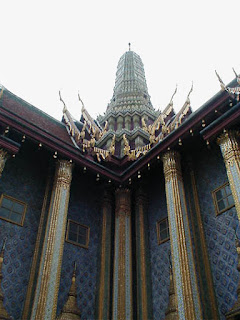

















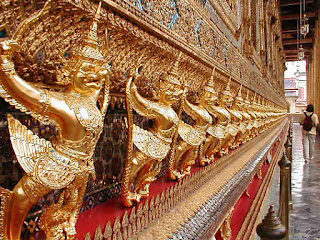



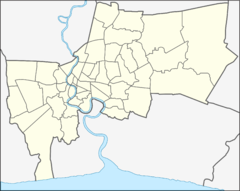



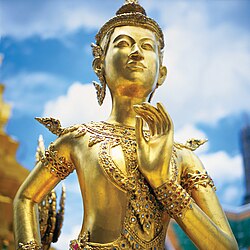
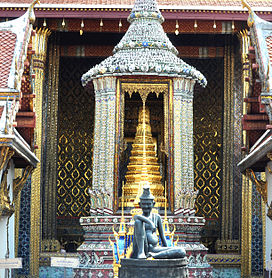


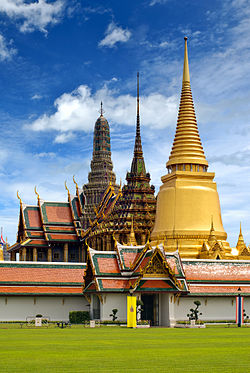



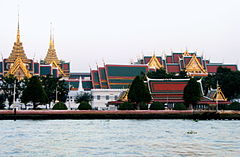
















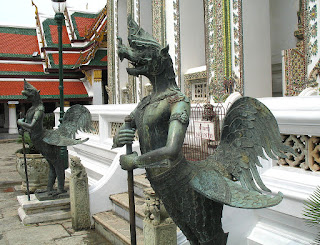

















ไม่มีความคิดเห็น:
แสดงความคิดเห็น